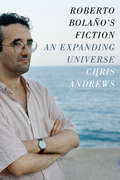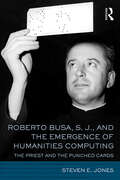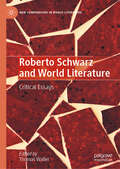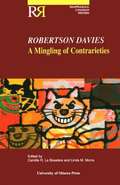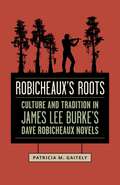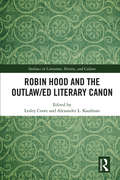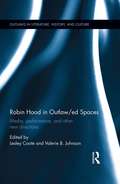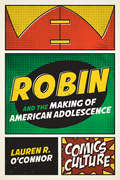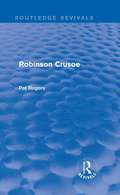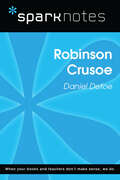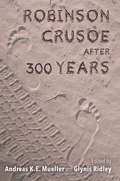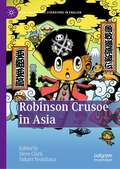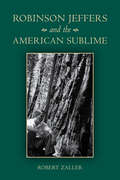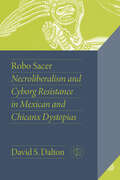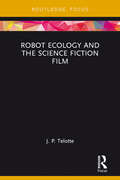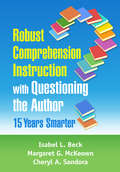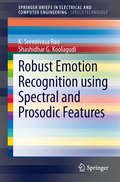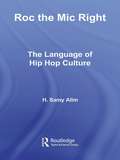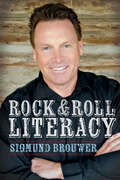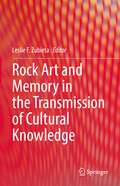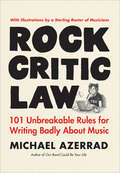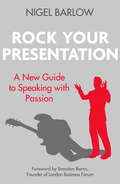- Table View
- List View
Roberto Bolaño's Fiction
by Chris AndrewsSince the publication of The Savage Detectives in 2007, the work of Roberto Bolaño (1953--2003) has achieved an acclaim rarely enjoyed in contemporary fiction. Chris Andrews, a leading translator of Bolaño's work into English, explores the singular achievements of the author's oeuvre, engaging with its distinct style and key thematic concerns, incorporating his novels and stories into the larger history of Latin American and global literary fiction.Andrews provides new readings and interpretations of Bolaño's novels, including 2666, The Savage Detectives, and By Night in Chile while at the same time examining the ideas and narrative strategies that unify his work. He begins with a consideration of the reception of Bolaño's fiction in English translation, examining the reasons behind its popularity. Subsequent chapters explore aspects of Bolaño's fictional universe and the political, ethical, and aesthetic values that shape it. Bolaño emerges as the inventor of a prodigiously effective "fiction-making system," a subtle handler of suspense, a chronicler of aimlessness, a celebrator of courage, an anatomist of evil, and a proponent of youthful openness. Written in a clear and engaging style, Roberto's Bolano's Fiction offers an invaluable understanding of one of the most important authors of the last thirty years.
Roberto Bolaño's Fiction: An Expanding Universe
by Chris AndrewsSince the publication of The Savage Detectives in 2007, the work of Roberto Bolaño (1953–2003) has achieved an acclaim rarely enjoyed by literature in translation. Chris Andrews, a leading translator of Bolaño's work into English, explores the singular achievements of the author's oeuvre, engaging with its distinct style and key thematic concerns, incorporating his novels and stories into the larger history of Latin American and global literary fiction.Andrews provides new readings and interpretations of Bolaño's novels, including 2666, The Savage Detectives, and By Night in Chile, while at the same time examining the ideas and narrative strategies that unify his work. He begins with a consideration of the reception of Bolaño's fiction in English translation, examining the reasons behind its popularity. Subsequent chapters explore aspects of Bolaño's fictional universe and the political, ethical, and aesthetic values that shape it. Bolaño emerges as the inventor of a prodigiously effective "fiction-making system," a subtle handler of suspense, a chronicler of aimlessness, a celebrator of courage, an anatomist of evil, and a proponent of youthful openness. Written in a clear and engaging style, Roberto Bolano's Fiction offers an invaluable understanding of one of the most important authors of the last thirty years.
Roberto Busa, S. J., and the Emergence of Humanities Computing: The Priest and the Punched Cards
by Steven E. JonesIt’s the founding myth of humanities computing and digital humanities: In 1949, the Italian Jesuit scholar, Roberto Busa, S.J., persuaded IBM to offer technical and financial support for the mechanized creation of a massive lemmatized concordance to the works of St. Thomas Aquinas. Using Busa’s own papers, recently accessioned in Milan, as well as IBM archives and other sources, Jones illuminates this DH origin story. He examines relationships between the layers of hardware, software, human agents, culture, and history, and answers the question of how specific technologies afford and even constrain cultural practices, including in this case the academic research agendas of humanities computing and, later, digital humanities.
Roberto Schwarz and World Literature: Critical Essays (New Comparisons in World Literature)
by Thomas WallerFirst of its kind, this essay collection examines the intellectual trajectory of Latin America’s foremost literary critic and dialectician, underscoring its relevance for contemporary debates on world literature. The volume shows how Schwarz’s concrete analyses of Brazilian literature and culture offer a theoretical blueprint to understand the literary registration of capitalism’s combined and uneven development. Exploring concepts such as misplaced ideas, objective form, and volubility, the contributors show how the nuance of Schwarz’s interpretive practice can be productively remodelled into a program for world-literary studies. Throughout the volume, Schwarz’s unparalleled contributions to cultural theory, long neglected in the Anglophone academy, are rigorously and creatively debated. Roberto Schwarz and World Literature is a primer on literary criticism as concrete practice and an indispensable book for those interested in how literary form mediates social reality.
Robertson Davies: A Mingling of Contrarieties
by Camille R. La Bossiere Linda M. MorraThis collection of essays on the writing of Robertson Davies addresses the basic problems in reading his work by looking at the topics of doubling, disguise, irony, paradox, and dwelling in "gaps" or spaces "in between."
Robicheaux's Roots: Culture and Tradition in James Lee Burke's Dave Robicheaux Novels
by Patricia M. GaitelyJames Lee Burke developed the character of Cajun detective Dave Robicheaux through twenty mystery novels published over three decades. Despite readers' increasing interest in Detective Robicheaux, his habits and preferences originate from a culture still unfamiliar to many of the books' fans. In Robicheaux's Roots, Patricia M. Gaitely explores the music, food, language, and folklore of southwest Louisiana and illuminates the cultural sources that Burke incorporated into this gripping series. Part of Robicheaux's appeal, Gaitely shows, rests in his connection to his hometown of New Iberia, with its faults, charm, and reliance on the old ways. Multiple cultural strands coexist in this region, including Creole and Cajun French dialect; African American folk sayings; swamp pop, zydeco, and blues music; and voodoo, Catholicism, evangelicalism, and faith healing. These aspects of Cajun life weave throughout Robicheaux's world. The commingling of so many traditions provides multiple meanings for even the most common encounters--water can be both natural element and medium between living and dead; and gumbo, jambalaya, and crawfish may represent more than simply regional foods. Additionally, Gaitely demonstrates that beneath the pleasant veneer of southern hospitality, a persistent legacy of violence and vengeance leaves a lasting mark on the lives of Robicheaux and the other characters. Robicheaux's Roots reveals how elements of south Louisiana's culture signal a sense of belonging but also recall the area's history of isolation. As a result, readers gain a deeper understanding of Robicheaux himself and an enhanced appreciation for Burke's acclaimed series.
Robin Hood and the Outlaw/ed Literary Canon (Outlaws in Literature, History, and Culture)
by Alexander L. Kaufman Lesley CooteThis cutting-edge volume demonstrates both the literary quality and the socio-economic importance of works on "the matter of the greenwood" over a long chronological period. These include drama texts, prose literature and novels (among them, children's literature), and poetry. Whilst some of these are anonymous, others are by acknowledged canonical writers such as William Shakespeare, Ben Jonson, and John Keats. The editors and the contributors argue that it is vitally important to include Robin Hood texts in the canon of English literary works, because of the high quality of many of these texts, and because of their significance in the development of English literature.
Robin Hood in Outlaw/ed Spaces: Media, Performance, and Other New Directions (Outlaws in Literature, History, and Culture)
by Lesley Coote Valerie B. JohnsonFollowing in the tradition of recent work by cultural geographers and historians of maps, this collection examines the apparently familiar figure of Robin Hood as he can be located within spaces that are geographical, cultural, and temporal. The volume is divided into two sections: the first features an interrogation of the literary and other textually transmitted spaces to uncover the critical grounds in which the Robin Hood ’legend’ has traditionally operated. The essays in Part Two take up issues related to performative and experiential space, demonstrating the reciprocal relationship between page, stage, and lived experience. Throughout the volume, the contributors contend with, among other things, modern theories of gender, literary detective work, and the ways in which the settings that once advanced court performances now include digital gaming and the enactment of ’real’ lives.
Robin and the Making of American Adolescence (Comics Culture)
by Lauren R. O'ConnorHoly adolescence, Batman! Robin and the Making of American Adolescence offers the first character history and analysis of the most famous superhero sidekick, Robin. Debuting just a few months after Batman himself, Robin has been an integral part of the Dark Knight’s history—and debuting just a few months prior to the word “teenager” first appearing in print, Robin has from the outset both reflected and reinforced particular images of American adolescence. Closely reading several characters who have “played” Robin over the past eighty years, Robin and the Making of American Adolescence reveals the Boy (and sometimes Girl!) Wonder as a complex figure through whom mainstream culture has addressed anxieties about adolescents in relation to sexuality, gender, and race. This book partners up comics studies and adolescent studies as a new Dynamic Duo, following Robin as he swings alongside the ever-changing American teenager and finally shining the Bat-signal on the latter half of “Batman and—.”
Robinson Crusoe (Routledge Revivals)
by Pat RogersFirst published in 1979, this title presents the basic facts and the background information needed by a modern reader of Robinson Crusoe, as well as a careful exploration of the structure and style of the work itself. Pat Rogers pays particular attention to the book’s composition and publishing history, the critical history surrounding it from 1719 onwards, and the contemporary context of geographical discovery, colonialism and piracy, as well as more controversial areas of interpretation. A wide-ranging and practical reissue, this study will be of value to literature students with a particular interest in the critical interpretation of Robinson Crusoe, as well as the novel’s place in the context of Defoe’s career.
Robinson Crusoe (SparkNotes Literature Guide Series)
by SparkNotesRobinson Crusoe (SparkNotes Literature Guide) by Daniel Defoe Making the reading experience fun! Created by Harvard students for students everywhere, SparkNotes is a new breed of study guide: smarter, better, faster. Geared to what today's students need to know, SparkNotes provides: *Chapter-by-chapter analysis *Explanations of key themes, motifs, and symbols *A review quiz and essay topicsLively and accessible, these guides are perfect for late-night studying and writing papers
Robinson Crusoe after 300 Years (Transits: Literature, Thought & Culture 1650-1850)
by Maximillian E. Novak Glynis Ridley Pat Rogers Geoffrey Sill Laura Schafer Brown Jeremy Chow Amy Hicks Scott Pyrz Andreas K Mueller Benjamin Pauley Daniel YuWhen The Life and Strange Surprizing Adventures of Robinson Crusoe and The Farther Adventures of Robinson Crusoe first published in 1719, Defoe could not have imagined that his protagonist would enjoy global recognition 300 years later. With no shortage of explanations for its longevity, Defoe’s tour de force has been interpreted as both religious allegory and frontier myth, its hero viewed variously as the self-sufficient adventurer and the archetypal colonizer and capitalist. Defoe’s original has been reimagined multiple times in legions of Robinsonade or castaway stories, but there is still more to say—the Crusoe myth is far from spent. The contributors to this wide-ranging collection suggest new and unfamiliar ways of thinking about this most familiar of works, asking us to consider the enduring appeal of “Crusoe", more recognizable today than ever before.
Robinson Crusoe in Asia (Asia-Pacific and Literature in English)
by Steve Clark Yukari YoshiharaThis collection of essays expands the study of that immensely widely read and much-adapted novel, beyond the first book – The Life and Strange Surprising Adventures of Robinson Crusoe (usually known simply as Robinson Crusoe) – to take in the far less well-known Farther Adventures and the almost unread Serious Reflections, beyond Defoe’s texts, to their re-writing and adaptation and beyond the Atlantic and South American context to an Asian and Pacific context. The essays consider both how Asia is represented in the books (in terms of politics, economics, religion), and how the book has been received, adapted, and taught, particularly in Asian contexts.
Robinson Jeffers and the American Sublime
by Robert ZallerRobinson Jeffers and the American Sublimeis the most comprehensive and most substantial critical work ever devoted to the major American poet Robinson Jeffers (1887-1962). Jeffers, the best known poet of California and the American West, particularly valorized the Big Sur region, making it his own as Frost did New England and Faulkner, Mississippi, and connecting it to the wider tradition of the American sublime in Emerson, Thoreau, and John Muir. The book also links Jeffers to a Puritan sublime in early American verse and explores his response to the Darwinian and Freudian revolutions and his engagement with modern astronomy. This discussion leads to a broad consideration of Jeffers' focus on the figure of Christ as emblematic of the human aspiration toward God-a God whom Jeffers defines not in Christian terms but in those of an older materialist pantheism and of modern science. The later sections of the book develop a conspectus of the democratic sublime that addresses American exceptionalism through the prism of Jeffers' Jeffersonian ethos. A final chapter places Jeffers' poetic thought in the larger cosmological perspective he sought in his late works.
Robo Sacer: Necroliberalism and Cyborg Resistance in Mexican and Chicanx Dystopias (Critical Mexican Studies)
by David S. DaltonRobo Sacer engages the digital humanities, critical race theory, border studies, biopolitical theory, and necropolitical theory to interrogate how technology has been used to oppress people of Mexican descent—both within Mexico and in the United States—since the advent of the North American Free Trade Agreement (NAFTA) in 1994. As the book argues, robo-sacer identity emerges as transnational flows of bodies, capital, and technology become an institutionalized state of exception that relegates people from marginalized communities to the periphery. And yet the same technology can be utilized by the oppressed in the service of resistance. The texts studied here represent speculative stories about this technological empowerment. These texts theorize different means of techno-resistance to key realities that have emerged within Mexican and Chicano/a/x communities under the rise and reign of neoliberalism. The first three chapters deal with dehumanization, the trafficking of death, and unbalanced access to technology. The final two chapters deal with the major forms of violence—feminicide and drug-related violence—that have grown exponentially in Mexico with the rise of neoliberalism. These stories theorize the role of technology both in oppressing and in providing the subaltern with necessary tools for resistance.Robo Sacer builds on the previous studies of Sayak Valencia, Irmgard Emmelhainz, Guy Emerson, Achille Mbembe, and of course Giorgio Agamben, but it differentiates itself from them through its theorization on how technology—and particularly cyborg subjectivity—can amend the reigning biopolitical and necropolitical structures of power in potentially liberatory ways. Robo Sacer shows how the cyborg can denaturalize constructs of zoē by providing an outlet through which the oppressed can tell their stories, thus imbuing the oppressed with the power to combat imperialist forces.
Robot Ecology and the Science Fiction Film (Routledge Focus on Film Studies)
by J. P. TelotteThis book offers the first specific application in film studies of what is generally known as ecology theory, shifting attention from history to the (in this case media) environment. It takes the robot as its subject because it has attained a status that resonates not only with some of the key concerns of contemporary culture over the last century, but also with the very nature of film. While the robot has given us a vehicle for exploring issues of gender, race, and a variety of forms of otherness, and increasingly for asking questions about the very nature and meaning of life, this image of an artificial being, typically anthropomorphic, also invariably implicates the cinema’s own and quite fundamental artificing of the human. Looking across genres, across specific media forms, and across closely linked conceptualizations, Telotte sketches a context of interwoven influences and meanings. The result is that this study of the cinematic robot, while mainly focused on science fiction film, also incorporates its appearance in, for example, musicals, cartoons, television, advertising, toys, and literature.
Robot Ghosts and Wired Dreams: Japanese Science Fiction from Origins to Anime
by Takayuki Tatsumi Christopher Bolton Istvan Csicsery-Ronay JR.Since the end of the Second World War—and particularly over the last decade—Japanese science fiction has strongly influenced global popular culture. Unlike American and British science fiction, its most popular examples have been visual—from Gojira (Godzilla) and Astro Boy in the 1950s and 1960s to the anime masterpieces Akira and Ghost in the Shell of the 1980s and 1990s—while little attention has been paid to a vibrant tradition of prose science fiction in Japan. Robot Ghosts and Wired Dreams remedies this neglect with a rich exploration of the genre that connects prose science fiction to contemporary anime. Bringing together Western scholars and leading Japanese critics, this groundbreaking work traces the beginnings, evolution, and future direction of science fiction in Japan, its major schools and authors, cultural origins and relationship to its Western counterparts, the role of the genre in the formation of Japan&’s national and political identity, and its unique fan culture. Covering a remarkable range of texts—from the 1930s fantastic detective fiction of Yumeno Kyûsaku to the cross-culturally produced and marketed film and video game franchise Final Fantasy—this book firmly establishes Japanese science fiction as a vital and exciting genre. Contributors: Hiroki Azuma; Hiroko Chiba, DePauw U; Naoki Chiba; William O. Gardner, Swarthmore College; Mari Kotani; Livia Monnet, U of Montreal; Miri Nakamura, Stanford U; Susan Napier, Tufts U; Sharalyn Orbaugh, U of British Columbia; Tamaki Saitô; Thomas Schnellbächer, Berlin Free U. Christopher Bolton is assistant professor of Japanese at Williams College. Istvan Csicsery-Ronay Jr. is professor of English at DePauw University. Takayuki Tatsumi is professor of English at Keio University.
Robur the Conqueror (Early Classics Of Science Fiction Ser.)
by Jules VerneFirst complete English translation of Jules Verne's classic novel of flight At the Weldon Institute in Philadelphia, a mob of zealous balloon enthusiasts plans to conquer the sky in a state-of-the-art dirigible. When a stranger, the mysterious Robur, declares that the future belongs not to balloons but to heavier-than-air flying machines, the Institute scornfully dismisses the idea. But Robur demands vengeance—and has a unique flying machine that will allow him to take it. By turns an impassioned argument for aviation, a wild proto-steampunk adventure, and a jubilant celebration of the dream of flight, Robur the Conqueror ranks among Jules Verne's most iconic and influential works. Its technological speculations, including the unforgettable aircraft Albatross, are a vibrant snapshot of nineteenth-century scientific innovation. This, the first complete English translation of Verne's 1886 novel, includes an insightful introduction, explanatory chapter notes, never-before-published glimpses of Verne's original manuscript, all the first-edition illustrations by Léon Benett, and an up-to-date Verne biography and primary and secondary bibliography. It is an essential new edition of a seminal science fiction classic.
Robust Comprehension Instruction with Questioning the Author: 15 Years Smarter
by Isabel L. Beck Margaret G. McKeown Cheryl A. SandoraThis practical K–12 teacher resource explains the "whats," "whys," and "how-tos" of using Questioning the Author (QtA), a powerful approach for enhancing reading comprehension and engagement. Thorough yet concise, the book shows how to plan lessons using both narrative and expository texts, formulate open-ended Queries, and guide class discussions around them. The authors discuss how QtA has evolved over many years of classroom application and include innovative ideas for integrating vocabulary instruction and writing prompts into QtA lessons. Also provided are steps for gradually transitioning from teacher-led instruction to independent reading. The book features extended examples of teachers implementing QtA, as well as four complete texts that can be downloaded and printed for classroom use.
Robust Emotion Recognition using Spectral and Prosodic Features
by K. Sreenivasa Rao Shashidhar G. KoolagudiIn this brief, the authors discuss recently explored spectral (sub-segmental and pitch synchronous) and prosodic (global and local features at word and syllable levels in different parts of the utterance) features for discerning emotions in a robust manner. The authors also delve into the complementary evidences obtained from excitation source, vocal tract system and prosodic features for the purpose of enhancing emotion recognition performance. Features based on speaking rate characteristics are explored with the help of multi-stage and hybrid models for further improving emotion recognition performance. Proposed spectral and prosodic features are evaluated on real life emotional speech corpus.
Roc the Mic Right: The Language of Hip Hop Culture
by H. Samy AlimComplementing a burgeoning area of interest and academic study, Roc the Mic Right explores the central role of language within the Hip Hop Nation (HHN). With its status convincingly argued as the best means by which to read Hip Hop culture, H. Samy Alim then focuses on discursive practices, such as narrative sequencing and ciphers, or lyrical circles of rhymers. Often a marginalized phenomenon, the complexity and creativity of Hip Hop lyrical production is emphasised, whilst Alim works towards the creation of a schema by which to understand its aesthetic. Using his own ethnographic research, Alim shows how Hip Hop language could be used in an educational context and presents a new approach to the study of the language and culture of the Hip Hop Nation: 'Hiphopography'. The final section of the book, which includes real conversational narratives from Hip Hop artists such as The Wu-Tang Clan and Chuck D, focuses on direct engagement with the language. A highly accessible and lively work on the most studied and read about language variety in the United States, this book will appeal not only to language and linguistics researchers and students, but holds a genuine appeal to anyone interested in Hip Hop or Black African Language.
Rock & Roll Literacy
by Sigmund BrouwerBestselling author Sigmund Brouwer brings his unique sense of play to the serious business of learning to read and write. Armed with music, humor and heart, he connects the dots for people who work with kids to cultivate reading and writing skills. The love of writing begins and ends with the love of story. Story can connect child to teacher. Story can teach reading and writing. Anyone can enjoy a story. Anyone can create a story. Anyone can revise a story.
Rock Art and Memory in the Transmission of Cultural Knowledge
by Leslie F. ZubietaThis book shares timely and thought-provoking methodological and theoretical approaches from perspectives concerning landscape, gender, cognition, neural networks, material culture and ontology in order to comprehend rock art’s role in memorisation processes, collective memory, and the intergenerational circulation of knowledge. The case studies offered here stem from human experiences from around the globe—Africa, Australia, Europe, North and South America—, which reflects the authors’ diverse interpretative stances. While some of the approaches deal with mnemonics, new digital technologies and statistical analysis, others examine performances, sensory engagement, language, and political disputes, giving the reader a comprehensive view of the myriad connections between memory studies and rock art. Indigenous interlocutors participate as collaborators and authors, creating space for Indigenous narratives of memory. These narratives merge with Western versions of past and recent memories in order to construct jointly novel inter-epistemic understandings of images made on rock. Each chapter demonstrates the commitment of rock art studies to strengthen and enrich the field by exploring how communities and cultures across time have perceived and entangled rock images with a broad range of material culture, nonhumans, people, emotions, performances, sounds and narratives. Such relations are pivotal to understanding the universe behind the intersections of memory and rock art and to generating future interdisciplinary collaborative studies.
Rock Critic Law: 101 Unbreakable Rules for Writing Badly About Music
by Michael AzerradStraight out of his beloved Twitter feed @RockCriticLaw, acclaimed rock journalist and author of the classic books Come As You Are: The Story of Nirvana and Our Band Could Be Your Life, Michael Azerrad turns his trenchant eye to the art of rock writing itself, hilariously skewering 101 of the genre’s seemingly endless litany of hackneyed phrases and tropes.One of the finest music writers today, Michael Azerrad has catalogued the shortcuts, lazy metaphors and uninspired prose that so many of his beloved colleagues all too regularly rely on to fill column inches. In 2014, he began his wickedly droll Twitter feed @RockCriticLaw to expose and make fun of this word-hash. Now, he consolidates these "Laws" into one witty, comprehensive and fully illustrated volume.Rock Critic Law includes timeless gems such as:If a band pioneered something, you must say they are "seminal." That is the Seminal Law of Rock Criticism.If a recording features densely layered guitars, then you MUST use the phrase "sonic cathedrals."Even when it’s easy to find out with research, by all means ask a band how they got their name.Please feel free to deny an artist’s individuality and say they are "the new [x]."If two guitars play a melodic line in harmony, you MUST say they are "twin lead guitars."All 101 Rock Critic Laws are accompanied by original illustrations from Ed Fotheringham, beloved Seattle scenester and highly regarded artist who has created album covers for everyone from, well, seminal grunge band Mudhoney to iconic jazz label Verve Records, as well as illustrations for TheAtlantic, Vanity Fair, The New Yorker and more, making this book a must-have for music lovers everywhere. A unique appreciation of music writing from one of its own, Rock Critic Law irreverently captures all the passion and furor of fandom.
Rock Your Presentation: A New Guide to Speaking with Passion
by Nigel BarlowThis book will protect your audiences from the following disorders:· Death by PowerPoint· Tedium· Compulsive fidgeting· Losing-the-Will-to-Live SyndromeNearly all of us have to pitch or present our ideas, whether in a formal setting like a theatre, at a company conference, in a classroom or even selling a concept one-to-one to our boss. In Rock your Presentation, Nigel Barlow, a professional keynote speaker and creative coach to many of the world's most famous organisations, gives you inspiring insights and practical techniques to 'rock up' your presentation or speech. Many of these tips come from exploring what makes great music so moving and impactful, and are easy to apply to make your own talks more dynamic and memorable. Try changing your key for different emotional impact; come up with a stronger chorus and an exciting climax; create your speaker's rider; be a protest singer to unleash your passion; and learn when and how to go unplugged to touch your audience. Whether you want to create a whole new presentation or tune up a tired old one, Rock Your Presentation will give you plenty of fresh ideas.
